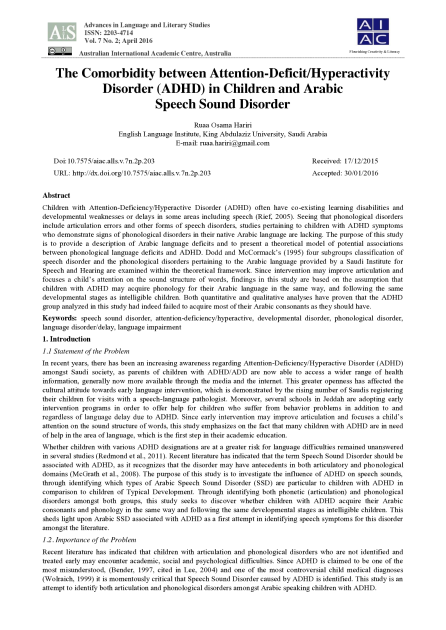The Comorbidity between Attention-Deficit/Hyperactivity Disorder (ADHD) in Children and Arabic Speech Sound Disorder

- Ruaa Osama Hariri
Advances in Language and Literary Studies
10.7575/aiac.alls.v.7n.2p.203Abstract
Children with Attention-Deficiency/Hyperactive Disorder (ADHD) often have co-existing learning disabilities and developmental weaknesses or delays in some areas including speech (Rief, 2005). Seeing that phonological disorders include articulation errors and other forms of speech disorders, studies pertaining to children with ADHD symptoms who demonstrate signs of phonological disorders in their native Arabic language are lacking. The purpose of this study is to provide a description of Arabic language deficits and to present a theoretical model of potential associations between phonological language deficits and ADHD. Dodd and McCormack"s (1995) four subgroups classification of speech disorder and the phonological disorders pertaining to the Arabic language provided by a Saudi Institute for Speech and Hearing are examined within the theoretical framework. Since intervention may improve articulation and focuses a child"s attention on the sound structure of words, findings in this study are based on the assumption that children with ADHD may acquire phonology for their Arabic language in the same way, and following the same developmental stages as intelligible children. Both quantitative and qualitative analyses have proven that the ADHD group analyzed in this study had indeed failed to acquire most of their Arabic consonants as they should have.
Keywords
Comorbidity, Developmental Disorder, Language, Speech sound disorder, featured, riyadh, studyCitation
Hariri, R.O. (). The Comorbidity between Attention-Deficit/Hyperactivity Disorder (ADHD) in Children and Arabic Speech Sound Disorder. ALLS, 7(2), 203-218, doi: 10.7575/aiac.alls.v.7n.2p.203
Link to this page: https://res.adhd.org.sa/doi/10.7575/aiac.alls.v.7n.2p.203